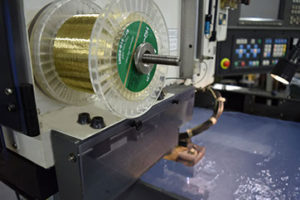Wire Electrode Discharge Machining (EDM) is a highly accurate process used to produce complex shapes and precision components.
This method of machining involves the use of an electrode wire that conducts electrical current as it moves through a conductive material such as metal, graphite, or plastic.
With wire EDM, materials can be cut into intricate shapes with extreme accuracy and repeatability, making it perfect for producing parts with fine details and close tolerances.
In this blog post, we’ll explore the different materials that are commonly used in wire EDM operations, examine common applications across industries ranging from automotive to medical device manufacturing, and discuss some of the benefits provided by this innovative precision machining approach.
Introducing wire EDM and its uses
Wire EDM, or wire electrical discharge machining, is a technology that uses a thin wire as an electrode to cut through metal. This precision cutting process is especially useful for creating intricate designs and shapes in metals that may be too difficult to cut with traditional machining methods.
Wire EDM is widely used in industries such as aerospace, medical equipment, and automotive manufacturing. In aerospace, it’s used to create complex components for aircraft engines, while medical equipment companies use it to create custom implants and surgical tools.
In the automotive industry, wire EDM is used to create molds and stamping dies. With its high precision and speed, wire EDM is a valuable tool in the world of manufacturing.
Understanding the different types of materials used in wire EDM
Wire EDM, or electrical discharge machining, is a process used to create intricate shapes and designs on metal materials. To achieve these intricate designs, different types of materials are used in the wire EDM process.
Understanding the different types of materials used in wire EDM is crucial, as it will help you select the best material for your project. Copper and brass wires are frequently used, as they conduct electricity well and have a low melting point.
Tungsten and molybdenum wires, on the other hand, are known for their high melting points and durability. Other materials, like zinc-coated wires and silver alloy wires, also have unique properties that make them suitable for specific tasks.
By understanding the properties of each material, you can choose the best material for your specific project, saving time and ensuring high-quality results.
What are the benefits of using wire EDM for precision machining applications
Wire EDM, also known as wire electrical discharge machining, has become an increasingly popular method for precision machining applications.
This technology involves using a thin wire to cut through a conductive material, with the wire being controlled by computer-aided design software.
What sets wire EDM apart from other machining methods is its ability to produce extremely precise cuts, making it a top choice for creating parts with complex geometries.
In addition, wire EDM can be used on a variety of materials, including those that are difficult to machine using traditional methods.
Other benefits of wire EDM include reduced tool wear, shorter production times, and a high level of repeatability. All of these advantages make wire EDM an ideal choice for industries that require tight tolerances and complex components, such as aerospace, medical, and automotive.
Applications of wire EDM in various industries
Wire Electrical Discharge Machining (EDM) technology is being widely used across various industries owing to the many benefits it offers.
With the ability to cut hard materials with extreme precision and no mechanical contact, it has become a popular choice for industries that manufacture parts requiring tight tolerances or that are too complex for traditional machining.
For instance, the aerospace industry uses wire EDM to produce turbine blades, fuel injectors, and landing gear parts. Similarly, the medical industry uses the technology to carve intricate shapes into surgical tools and implants.
Other areas that use wire EDM include electronics, automotive, and jewelry manufacturing. The accuracy and precision of wire EDM make it a cost-effective solution for companies looking for high-quality part production.
Potential cost savings with implementation of wire EDM over other machining techniques
For any business looking to optimize its operations, cost savings are always a top priority. In the world of machining, wire EDM has emerged as a game-changing technology, offering faster, more precise machining and superior surface finishes.
But beyond these performance benefits, wire EDM can also help businesses save money in the long run by minimizing tooling costs, reducing labor requirements, and improving efficiency overall.
By analyzing the potential cost savings of wire EDM over traditional machining techniques, businesses can make informed decisions about how best to allocate their resources and stay competitive in today’s dynamic market.
Challenges associated with using wire EDM
Wire electrical discharge machining (EDM) is widely used in today’s manufacturing for its precise cutting abilities, but it does come with its own set of challenges.
One of the biggest issues with wire EDM is the difficulty of getting straight edges and sharp corners due to the nature of the wire’s path.
Additionally, wire EDM generates a lot of heat, which can deform the material being cut or even create cracks. Finally, the wire has to be managed properly to ensure it doesn’t break or get too short, which would mean stopping a job and wasting material.
However, with proper training and attention to detail, these challenges can be overcome, and wire EDM can be a valuable tool in producing high-quality parts.
In conclusion, wire EDM has revolutionized the world of precision machining with its accuracy and improved efficiency. If you are in need of high-precision parts with intricate shapes, wire EDM can be a great fit. Take advantage of this technology and contact us today to learn more about how wire EDM can help you save time and money!

